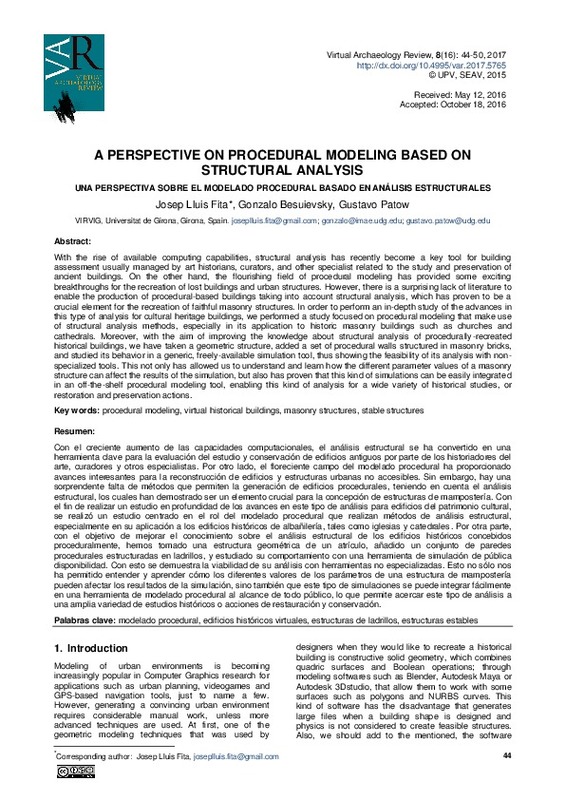JavaScript is disabled for your browser. Some features of this site may not work without it.
Buscar en RiuNet
Listar
Mi cuenta
Estadísticas
Ayuda RiuNet
Admin. UPV
A perspective on procedural modeling based on structural analysis
Mostrar el registro sencillo del ítem
Ficheros en el ítem
| dc.contributor.author | Fita, Josep Lluis
|
es_ES |
| dc.contributor.author | Besuievsky, Gonzalo
|
es_ES |
| dc.contributor.author | Patow, Gustavo
|
es_ES |
| dc.date.accessioned | 2017-06-13T07:08:41Z | |
| dc.date.available | 2017-06-13T07:08:41Z | |
| dc.date.issued | 2017-05-22 | |
| dc.identifier.uri | http://hdl.handle.net/10251/82699 | |
| dc.description.abstract | [EN] With the rise of available computing capabilities, structural analysis has recently become a key tool for building assessment usually managed by art historians, curators, and other specialist related to the study and preservation of ancient buildings. On the other hand, the flourishing field of procedural modeling has provided some exciting breakthroughs for the recreation of lost buildings and urban structures. However, there is a surprising lack of literature to enable the production of procedural-based buildings taking into account structural analysis, which has proven to be a crucial element for the recreation of faithful masonry structures. In order to perform an in-depth study of the advances in this type of analysis for cultural heritage buildings, we performed a study focused on procedural modeling that make use of structural analysis methods, especially in its application to historic masonry buildings such as churches and cathedrals. Moreover, with the aim of improving the knowledge about structural analysis of procedurally-recreated historical buildings, we have taken a geometric structure, added a set of procedural walls structured in masonry bricks, and studied its behavior in a generic, freely-available simulation tool, thus showing the feasibility of its analysis with non-specialized tools. This not only has allowed us to understand and learn how the different parameter values of a masonry structure can affect the results of the simulation, but also has proven that this kind of simulations can be easily integrated in an off-the-shelf procedural modeling tool, enabling this kind of analysis for a wide variety of historical studies, or restoration and preservation actions. | es_ES |
| dc.description.abstract | [ES] Con el creciente aumento de las capacidades computacionales, el análisis estructural se ha convertido en una herramienta clave para la evaluación del estudio y conservación de edificios antiguos por parte de los historiadores del arte, curadores y otros especialistas. Por otro lado, el floreciente campo del modelado procedural ha proporcionado avances interesantes para la reconstrucción de edificios y estructuras urbanas no accesibles. Sin embargo, hay una sorprendente falta de métodos que permiten la generación deedificios procedurales, teniendo en cuenta el análisis estructural, los cuales handemostrado ser un elemento crucial para la concepciónde estructuras de mampostería. Con el fin de realizar un estudio en profundidad de los avances en este tipo de análisis para edificios del patrimonio cultural, se realizó un estudio centrado en elroldelmodelado proceduralque realizanmétodos de análisis estructural, especialmente en su aplicación a los edificios históricos de albañilería, tales como iglesias y catedrales. Por otra parte, con el objetivo de mejorar el conocimiento sobre el análisis estructural de los edificios históricos concebidosproceduralmente, hemos tomado una estructura geométrica de un atrículo, añadidoun conjunto de paredesproceduralesestructuradasen ladrillos, y estudiado su comportamiento conuna herramienta de simulación de pública disponibilidad.Con esto sedemuestra la viabilidad de su análisis con herramientas no especializadas. Esto no sólo nos ha permitido entender y aprender cómo los diferentes valores de los parámetros de una estructura de mampostería pueden afectar los resultados de la simulación, sino tambiénque este tipo de simulaciones se puede integrar fácilmente en una herramienta de modelado proceduralal alcance de todo público, lo que permite acercar este tipo de análisis a una amplia variedad de estudios históricos o acciones de restauración y conservación. | es_ES |
| dc.description.sponsorship | This work was partially funded by the TIN2014-52211-C2-2-R project from Ministerio de Economia y Competividad, Spain. | |
| dc.language | Inglés | es_ES |
| dc.publisher | Universitat Politècnica de València | |
| dc.relation.ispartof | Virtual Archaeology Review | |
| dc.rights | Reconocimiento - No comercial - Sin obra derivada (by-nc-nd) | es_ES |
| dc.subject | Procedural modeling | es_ES |
| dc.subject | Virtual historical building | es_ES |
| dc.subject | Masonry structure | es_ES |
| dc.subject | Stable structures | es_ES |
| dc.subject | Modelado procedural | es_ES |
| dc.subject | Edificios históricos virtuale | es_ES |
| dc.subject | Estructuras de ladrillos | es_ES |
| dc.subject | Estructuras estables | es_ES |
| dc.title | A perspective on procedural modeling based on structural analysis | es_ES |
| dc.title.alternative | Una perspectiva sobre el modelado procedural basado en análisis estructurales | es_ES |
| dc.type | Artículo | es_ES |
| dc.date.updated | 2017-06-12T07:20:52Z | |
| dc.identifier.doi | 10.4995/var.2017.5765 | |
| dc.relation.projectID | info:eu-repo/grantAgreement/MINECO//TIN2014-52211-C2-2-R/ES/GENERACION, SIMULACION Y VISUALIZACION DE MODELOS 3D A PARTIR DE GRANDES CONJUNTOS DE DATOS. APLICACIONES EN LA MEJORA DE LA CALIDAD DE VIDA DE LAS PERSONAS Y SU ENTORNO/ | es_ES |
| dc.rights.accessRights | Abierto | es_ES |
| dc.description.bibliographicCitation | Fita, JL.; Besuievsky, G.; Patow, G. (2017). A perspective on procedural modeling based on structural analysis. Virtual Archaeology Review. 8(16):44-50. https://doi.org/10.4995/var.2017.5765 | es_ES |
| dc.description.accrualMethod | SWORD | es_ES |
| dc.relation.publisherversion | https://doi.org/10.4995/var.2017.5765 | es_ES |
| dc.description.upvformatpinicio | 44 | es_ES |
| dc.description.upvformatpfin | 50 | es_ES |
| dc.type.version | info:eu-repo/semantics/publishedVersion | es_ES |
| dc.description.volume | 8 | |
| dc.description.issue | 16 | |
| dc.identifier.eissn | 1989-9947 | |
| dc.contributor.funder | Ministerio de Economía y Competitividad |








